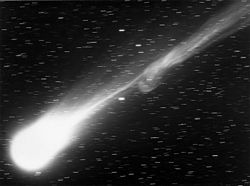C / 1996 B2 (Hyakutake)
| C / 1996 B2 (Hyakutake) [i] | |
|---|---|

|
|
| Properties of the orbit ( animation ) | |
| Orbit type | long-period |
| Numerical eccentricity | 0.99990 |
| Perihelion | 0.230 AU |
| Aphelion | ~ 4700 AU |
| Major semi-axis | ~ 2350 AU |
| Sidereal period | ~ 114,000 a |
| Inclination of the orbit plane | 124.922 ° |
| Perihelion | May 1, 1996 |
| Orbital velocity in the perihelion | 87.83 km / s |
| Physical properties of the core | |
| Medium diameter | 2 km |
| history | |
| Explorer | Y. Hyakutake |
| Date of discovery | January 30, 1996 |
| Older name | - |
| Source: Unless otherwise stated, the data comes from JPL Small-Body Database Browser . Please also note the note on comet articles . | |
The comet Hyakutake (Japanese pronunciation after IPA [ çakɯ̥take ], official name C / 1996 B2 ) is a long-period comet that could be observed with the naked eye in 1996. It was also known as The Great Comet of 1996 .
discovery
The comet was discovered on January 30, 1996 by Japanese amateur astronomer Yūji Hyakutake . It was the second comet known under this name. The first, C / 1995 Y1, had been discovered by Hyakutake just a few weeks earlier. While he was still observing his first comet - it was never freely visible - he found, to his great surprise, this second comet in almost the same position where he had already discovered the first.
Orbit
The comet Hyakutake orbits the sun in an extremely elongated, elliptical orbit . The point of the orbit closest to the Sun ( perihelion ), which the comet traversed on May 1, 1996, is 0.230 AU within the orbit of the planet Mercury , while the point furthest from the Sun ( aphelion ) with about 4700 AU is almost 1 ⁄ 10 light year from the Sun is away. Its orbit is inclined around 55 ° to the ecliptic . Since Hyakutake moves retrograde (retrograde) around the sun, the orbit inclination is given as 125 °.
The orbit of the comet was so severely disturbed by the gravitational effects of the gas giants during its passage in 1996 that its orbit period from about 8000 years (with an aphid distance of about 800 AU) before these orbital disturbances was extended to about 114,000 years.
visibility
Already the first orbit determinations showed that the comet would pass very close to the earth , at a distance of only 0.109 astronomical units . Since the comet Hale-Bopp, discovered in 1995 , had already been announced as a possible large comet, it took the astronomers some time to realize that Hyakutake would also be a spectacular phenomenon.
In the middle of March the comet was still pretty normal. It shone with the apparent brightness of a fourth magnitude star and its tail was about 5 ° long. As it got closer to the sun and earth, it quickly became brighter and its tail lengthened. When it came closest to Earth on March 25, 1996, it was one of the brightest objects in the night sky, and its tail stretched an impressive 75 degrees across the sky. The coma showed a clearly visible blue-green color.
Since Hyakutake was only visible in its greatest brightness for a few days, it was not able to attract as much public interest as the Comet Hale-Bopp in the following year. In addition, many European observers were unable to observe the comet on its brightest days due to unfavorable weather conditions . Many people who saw both Comet Hyakutake and Hale-Bopp considered Hyakutake to be the more impressive appearance.
The Ulysses spacecraft flew unplanned and unexpectedly through the comet's tail in May 1996. Based on this event, the tail length was determined to be at least 500 million kilometers. Observations from the earth established the existence of ethane and methane in the comet. It was the first time that these two gases were detected in comets. With the X-ray satellite ROSAT it was also found that Hyakutake emits X- rays, which has also not been observed in any other comet. Radar measurements from the Goldstone Observatory showed that the comet's core was only 2 km in size. Observations with the Hubble Space Telescope revealed that small fragments detached from the comet's nucleus, which then formed their own short tails.
